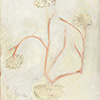PROVENANCE:
Jean-Claude Riedel, Paris
Private collection, Asia
This painting is to be sold with the certificate of authenticityissued by Jean-Claude Riedel
Catalogue Note:
POTTED WHITE PEONIES
SANYU
“Perhaps it would be more fitting to say that Sanyu’s works are like poems, like a kind of translucent quatrain that is so pure that you can only experience it but not prove it, as his wordings have no definition.” - Xun Jiang
In the beginning of the twentieth century, China gave birth to the exceptionally talented youth Sanyu. In 1921 at the age of twenty, he arrived at the cultural center of Paris, a city that agreed well with his free spirit and unparalleled gifts. From then on, Paris inherited Sanyu’s individualism and loneliness, inviting him to give back to the world through works translucent as morning dew that sparkle with nobility.
Unlike other hungry artists of his time who also made their way to Paris, such as Xu Beihong and Lin Fengmian, Sanyu did not express grandiose notions of patriotism in his art. With a natural confidence, he believed that he needn’t pressure himself to “chase after the advancements of the west,” but embrace his life in the blossoming city of romance with his mind, body and soul. As he submerged himself into the freedom of its cultural atmosphere, he enjoyed the intricacies of life at his own pace as well as the passions of love. Perhaps it was his lack of attachments that Sanyu, who had chosen to practice his artistic skills in Académie de la Grande Chaumiere instead of orthodox academic institutions shortly after arrived in Paris, was able to release his talents into the world in the late 1920s and continue to astound the Parisian art scene in the 1930s. His art reflects the precise minimalism of western modernism as well as the ethereal descriptions favored by eastern scholars. He never made a conscious effort to “blend eastern and western elements together”; instead, he allowed them to be absorbed into his soul on their own accord, and these spiritual elements from both Europe and China ingeniously converged into one another, piecing together touching images of a rare kind of beauty . “Potted White Peonies” is one representative of these ethereal paintings.
In the 1930s, Sanyu took the Parisian art scene by storm with his simplistic and elegant art style. The visual design of his works are concise yet descriptive. His color palettes are extremely minimalistic with a single painting usually consisting of merely three or four colors, his favorites including milky white, greys, and pinks. Many of his works were quite lowly saturated to the point of fading into obscurity entirely; otherwise, he would add ink blacks or dark blue to create a strong sense of contrast. During this time, Sanyu’s talents were critically acclaimed. Financial support from his older brother Chang Junmin meant that he did not have to rely on selling his works to make ends meet, granting him the luxury of exploring the bustling city of romance at his own pace. Despite this, the worlds he created with his brush retained an elegance with a lucidity akin to solitude. The wealthy grandeur of peonies is a rather apt representation of Sanyu’s rich blood, but his later work in 1950s like “Potted White Peonies”are anything but colorful to the point of being almost as colorless as pure white. The artist got rid of the peonies abundance of green leaves, leaving behind three white peonies blooming on thin pastel orange stalks. This simplistic image brings out the exquisite nobility of the peonies tinged with loneliness.
Flowers were Sanyu’s utmost favorite subjects, as they reflected all that he felt and experienced throughout his life. The center flower of the“Potted White Peonies” stands tall, blossoming with magnificence at the very top; the stem growing off to the right curves upward at a low vantage point, blooming with another white flower while the flower on the the left adds tension as it supports its fight to bloom at its turning point. The main stem branches off somewhere at its midpoint up above in a direct curve downwards, blossoming with a flower that seems to hum as it bows its head, introspective and shy. This alarming shift brings out a sense of resilience. Sanyu let his white peonies flower in a translucent glass pot, leaving us amazed at all its elegance, as their tiny, unassuming stalks grow from the glass pot while trembling with a disproportionate vitality. Just like the simple elegance of Sanyu’s style of this time, the simplistic imagery of the flowers and glass vase of “Potted White Peonies”are an illustrative existence, growing from a spacious background without depth. This calls back to the fauvist style lead by Matisse (Henri Matisse, 1869-1954). Yet, on the brink of its immortalized essence, it retains the artistic touch of a brush, the dynamic beauty of its line work supposedly drawn from the artist’s younger days of following the footsteps of the famous calligrapher Zhao Xi Xi, who set his foundation built with both vitality and nobility. Though the color palette of the artwork is quite pale, the oil paints flow on the canvas in many layers. The copper branches and grayish flowers layered upon a pastel white background tinged with a brownish vermilion leave much food for thought in its oriental tranquility.
If we describe this artwork as a painting “tinged with a reddish wash,” then Sanyu used the most delicate layer of ink he could, quietly blossoming by their own tune. Just as Xun Jiang once said, “Perhaps it would be more fitting to say that Sanyu’s works are like poems, like a kind of translucent quatrain that is so pure that you can only experience it but not prove it, as his wordings have no definition.” With its brisk colors, “Potted White Peonies” simplistic and pure essence shine through even amongst a world that continues to flourish.


